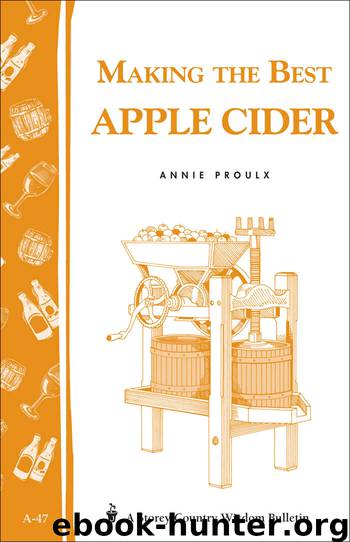Making the Best Apple Cider by Annie Proulx

Author:Annie Proulx
Language: eng
Format: epub
Publisher: Storey Publishing, LLC
Published: 2007-09-21T16:00:00+00:00
Storing and Preserving Sweet Cider
Refrigeration: Cider can be stored for short periods in clean glass or plastic jugs, or in waxed cardboard containers in a refrigerator at normal refrigeration temperatures. Depending on the condition of the fruit used to make the cider and the cleanliness of the grinding and pressing machinery, it can stay fresh-tasting from two to four weeks. If the machinery was not properly cleaned and harbored substantial colonies of yeasts and bacteria, you can expect fermentation to begin soon, or undesirable bacteria may grow.
Freezing: After refrigeration, the preferred method of preserving cider is freezing it in plastic or waxed cardboard containers. Most families use the half-gallon size as the contents can be consumed in a couple of days, but if large quantities of cider are at hand, this is a bulky procedure. Allow two inches in the necks of the containers for expansion during freezing. Defrost the cider for a day in the refrigerator when you want to drink it. You can keep frozen cider for a year with little deterioration in quality.
Pasteurizing in Bulk: Cider can be stored almost indefinitely on the pantry shelf by pasteurizing the juice and the preserving it in bottles or canning jars. This is the hot pack method using sterilized bottles with crown caps or regulation caning jars with new lids. If you use bottles and caps, you will need a bottle capper to affix the caps. You also need a metal-stemmed high temperature thermometer, such as the kind used for candy-making or deep frying. You will need a large kettle to sterilize the containers and keep them hot, and a stainless steel or unchipped enamel kettle in which to heat the cider. The acids in the juice will react with other metals and taint the cider. Bring the cider up to a temperature of 160°F and hold it there for fifteen seconds. Fill and cap the containers, place them on their sides on several layers of paper in a draft-free place, allow them to cool, then check to be sure they are properly sealed. Store in a cool, dark place.
Pasteurizing in the Bottle: Another method of pasteurization — one that retains more apple flavor because lower temperatures are used — is the Holding System where bottles are filled with cider, capped, and then pasteurized. Here you’ll need cappable bottles of one quart size or smaller, a water bath canner, and a high temperature thermometer. Save one bottle for a control bottle: into the neck of this bottle fit a cork which has been drilled through to snugly accept the thermometer stem, after filling the bottle with water. Fill the other bottles with cider, and cap. Place them in the canner rack and fill the canner with water until all the bottles are completely covered. Put an upside-down clean tuna fish can at the bottom of the canner and on it stand the water-filled control bottle. The cork and thermometer should be above water. Now heat the water until the thermometer registers 143°F.
Download
This site does not store any files on its server. We only index and link to content provided by other sites. Please contact the content providers to delete copyright contents if any and email us, we'll remove relevant links or contents immediately.
| Cheese & Dairy | Chocolate |
| Fish & Seafood | Fruits |
| Herbs, Spices & Condiments | Meat & Game |
| Natural Foods | Pasta & Noodles |
| Potatoes | Poultry |
| Rice & Grains | Vegetables |
The Sprouting Book by Ann Wigmore(3543)
Better Homes and Gardens New Cookbook by Better Homes & Gardens(3523)
Trullo by Tim Siadatan(3378)
Super Food Family Classics by Jamie Oliver(3366)
Hedgerow by John Wright(3272)
Panini by Carlo Middione(3248)
Bread Revolution by Peter Reinhart(3080)
Sauces by James Peterson(3048)
Jam by Jam (epub)(3020)
Ottolenghi - The Cookbook by Yotam Ottolenghi(2869)
Oh She Glows Every Day by Angela Liddon(2725)
My Pantry by Alice Waters(2542)
Hot Sauce Nation by Denver Nicks(2450)
The Culinary Herbal by Susan Belsinger(2429)
Veg by Jamie Oliver(2408)
Wanderlust by Jeff Krasno(2225)
Meathooked by Marta Zaraska(2220)
The Art of Making Gelato by Morgan Morano(2215)
Basic Illustrated Edible and Medicinal Mushrooms by Jim Meuninck(2185)
